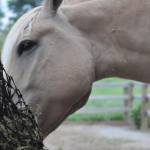Teff Hay: Potential Low-NSC Feedstuff for Horses

Sourcing hay for horses that require diets low in nonstructural carbohydrates (NSC) can be a frustrating exercise for even the most devoted owners and managers.
Hays made from warm-season grasses generally have fewer NSC than hays made from cool-season grasses, largely because warm-season grasses contain little or no fructan. Because of this, horsemen often turn to teff hay when searching for low-NSC forage.
Known also as summer lovegrass or annual lovegrass, teff is native to Africa, where it was grown as a grain crop for centuries. Its usefulness as a forage became apparent about 100 years ago. More recently, teff has been adapted to a range of climates and geographic regions, and more and more hay producers are growing it.
A primary advantage to forage producers includes teff’s resistance to disease and pests. Further, under ideal growing conditions, teff is easily established, thrives in drought-stressed or waterlogged soils, and can be harvested 40 to 55 days after planting. If sown in May in the Northern Hemisphere, some teff stands can be cut three, possibly four, times in a growing season with annual yield of 4 to 7 tons per acre, given sufficient rainfall.*,+
Horses generally find teff hay palatable, perhaps due in part to its soft texture. When harvested under optimal conditions, teff hay is fine-stemmed and leafy. In two-choice preference trials, mature mares unaccustomed to teff hay strongly preferred both full-bloom alfalfa and mature timothy hay.• In general, though, horses prefer legumes and cool-season grass hays over warm-season grass hay, so the results of these preference trials were not surprising to researchers. Once acclimated to teff, most horses consume it as they would other hays.
In a separate study that featured teff hay cut at three different stages of maturity (boot, early, and late), mature horses preferred the boot and early-maturity hays based on voluntary intake: 1.8% of body weight for boot, 1.7% of body weight for early, and 1.5% of bodyweight for late maturity.
At the intakes measured in this study, nutrient requirements for mature horses were generally met, though digestible energy and crude protein of late-maturity teff fell short of requirements.○ When fed late-maturity teff, horses with higher nutrient requirements may need supplemental feed, such as a well-fortified concentrate or a research-proven vitamin and mineral supplement.
In terms of its use for horses on NSC-restricted diets, teff hay is a go-to choice, as it is often low in NSC. In the latter study, for example, NSC ranged from 5.4% (boot) to 8.4 (late), below the recommended 10% of total intake.○ Feeding teff hay may be an effective strategy to decrease dietary digestible energy and to help reduce body weight, said the researchers.
Despite its appeal as a low-NSC forage, differences in growing conditions could change NSC values. As with many grasses, the carbohydrate concentration may depend on environmental conditions experienced by the plants during growth and harvest.
This underscores the importance of forage-testing as a tool in managing horses with insulin resistance, metabolic syndrome, and increased risk of laminitis. Once forage-testing results are in hand, consult with a qualified nutritionist and veterinarian to determine a safe nutritional plan for at-risk horses.
Of note, teff hay grown in some countries contain synephrine, a stimulant that causes vasoconstriction and increased heart rate. Further, synephrine may be used as an ingredient of herbal and nutritional supplements in the form of bitter orange extract, which is used as a flavouring agent. Many organizations that govern horse sport classify synephrine as a banned substance.
*Lacefield, G.D. Teff: Old plant, new use. University of Kentucky. Accessed July 1, 2020.
+Skillman, L. 2007. Teff may be a summer forage option. University of Kentucky. Accessed July 1, 2020.
•McCown, S., M. Brummer, S. Hayes, G. Olson, S.R. Smith, and L.M. Lawrence. 2012. Acceptability of teff hay by horses. Journal of Equine Veterinary Science 32:327-331.
○Stanier, W.B., J.R. Brussard, N.M. Repard, M.H. Hall, and A.O. Burk. 2010. Voluntary intake and digestibility of teff hay fed to horses. Journal of Animal Science 88:3296-3303.








